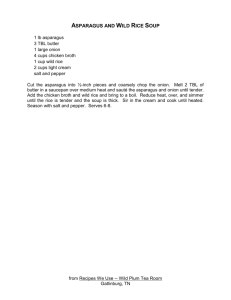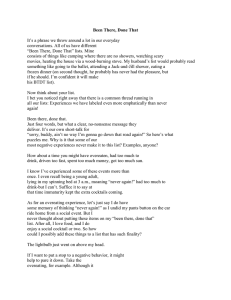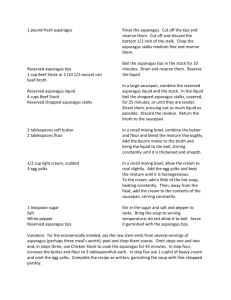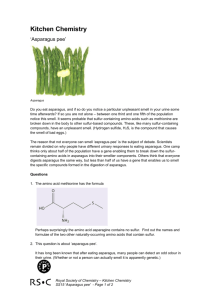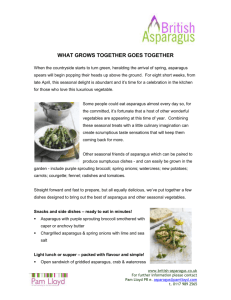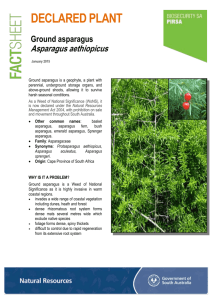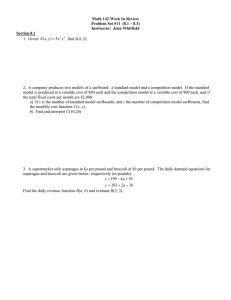Asparagus hybrid named “DePaoli”
advertisement
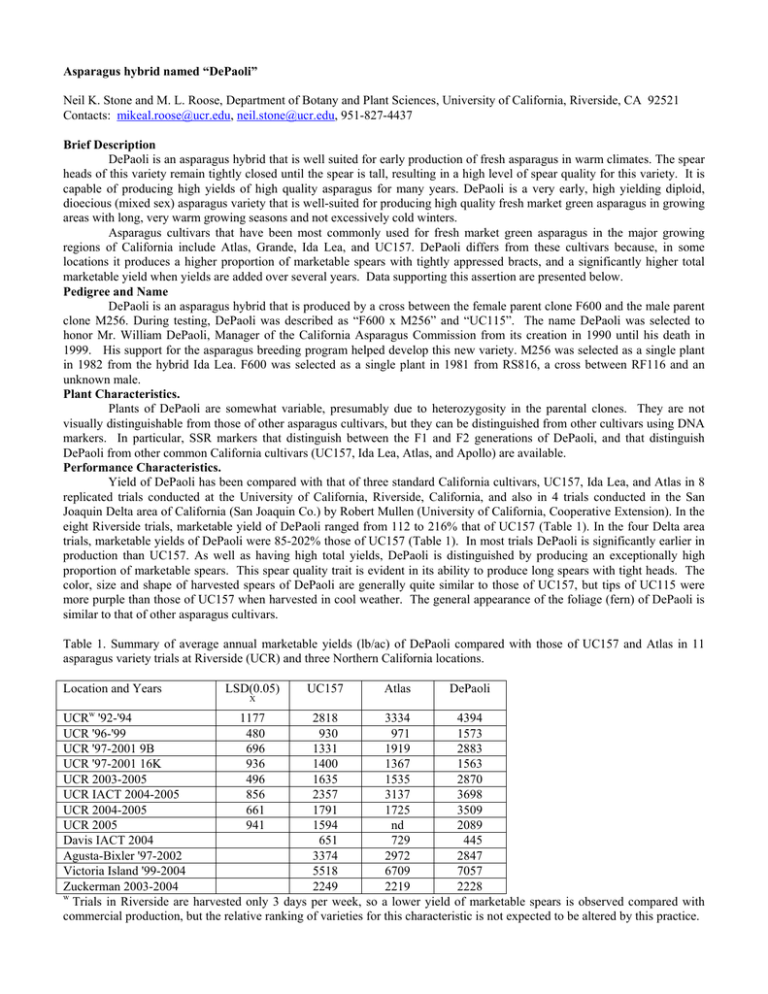
Asparagus hybrid named “DePaoli” Neil K. Stone and M. L. Roose, Department of Botany and Plant Sciences, University of California, Riverside, CA 92521 Contacts: mikeal.roose@ucr.edu, neil.stone@ucr.edu, 951-827-4437 Brief Description DePaoli is an asparagus hybrid that is well suited for early production of fresh asparagus in warm climates. The spear heads of this variety remain tightly closed until the spear is tall, resulting in a high level of spear quality for this variety. It is capable of producing high yields of high quality asparagus for many years. DePaoli is a very early, high yielding diploid, dioecious (mixed sex) asparagus variety that is well-suited for producing high quality fresh market green asparagus in growing areas with long, very warm growing seasons and not excessively cold winters. Asparagus cultivars that have been most commonly used for fresh market green asparagus in the major growing regions of California include Atlas, Grande, Ida Lea, and UC157. DePaoli differs from these cultivars because, in some locations it produces a higher proportion of marketable spears with tightly appressed bracts, and a significantly higher total marketable yield when yields are added over several years. Data supporting this assertion are presented below. Pedigree and Name DePaoli is an asparagus hybrid that is produced by a cross between the female parent clone F600 and the male parent clone M256. During testing, DePaoli was described as “F600 x M256” and “UC115”. The name DePaoli was selected to honor Mr. William DePaoli, Manager of the California Asparagus Commission from its creation in 1990 until his death in 1999. His support for the asparagus breeding program helped develop this new variety. M256 was selected as a single plant in 1982 from the hybrid Ida Lea. F600 was selected as a single plant in 1981 from RS816, a cross between RF116 and an unknown male. Plant Characteristics. Plants of DePaoli are somewhat variable, presumably due to heterozygosity in the parental clones. They are not visually distinguishable from those of other asparagus cultivars, but they can be distinguished from other cultivars using DNA markers. In particular, SSR markers that distinguish between the F1 and F2 generations of DePaoli, and that distinguish DePaoli from other common California cultivars (UC157, Ida Lea, Atlas, and Apollo) are available. Performance Characteristics. Yield of DePaoli has been compared with that of three standard California cultivars, UC157, Ida Lea, and Atlas in 8 replicated trials conducted at the University of California, Riverside, California, and also in 4 trials conducted in the San Joaquin Delta area of California (San Joaquin Co.) by Robert Mullen (University of California, Cooperative Extension). In the eight Riverside trials, marketable yield of DePaoli ranged from 112 to 216% that of UC157 (Table 1). In the four Delta area trials, marketable yields of DePaoli were 85-202% those of UC157 (Table 1). In most trials DePaoli is significantly earlier in production than UC157. As well as having high total yields, DePaoli is distinguished by producing an exceptionally high proportion of marketable spears. This spear quality trait is evident in its ability to produce long spears with tight heads. The color, size and shape of harvested spears of DePaoli are generally quite similar to those of UC157, but tips of UC115 were more purple than those of UC157 when harvested in cool weather. The general appearance of the foliage (fern) of DePaoli is similar to that of other asparagus cultivars. Table 1. Summary of average annual marketable yields (lb/ac) of DePaoli compared with those of UC157 and Atlas in 11 asparagus variety trials at Riverside (UCR) and three Northern California locations. Location and Years LSD(0.05) UC157 Atlas DePaoli X UCRw '92-'94 1177 2818 3334 4394 UCR '96-'99 480 930 971 1573 UCR '97-2001 9B 696 1331 1919 2883 UCR '97-2001 16K 936 1400 1367 1563 UCR 2003-2005 496 1635 1535 2870 UCR IACT 2004-2005 856 2357 3137 3698 UCR 2004-2005 661 1791 1725 3509 UCR 2005 941 1594 nd 2089 Davis IACT 2004 651 729 445 Agusta-Bixler '97-2002 3374 2972 2847 Victoria Island '99-2004 5518 6709 7057 Zuckerman 2003-2004 2249 2219 2228 w Trials in Riverside are harvested only 3 days per week, so a lower yield of marketable spears is observed compared with commercial production, but the relative ranking of varieties for this characteristic is not expected to be altered by this practice. 2 X LSD based on all entries in trial. DePaoli (as UC115) was entered in the 3rd International Asparagus cultivar trial, and included in trials in California, Canada, China, The Netherlands, Peru, Poland, and Spain. At this time, only results from the first harvest are available for most locations (see http://aesop.rutgers.edu/~iact/Asparagus/IACT.HTML). At most locations, yield of DePaoli was 85-95% that of UC157 except in China where it ranked #4 for yield and is considered promising. At the trial location in Yolo Co. California, which is located outside the main asparagus production region, yield was only 60% that of UC157. Overall, these early results suggest that its area of adaptation is narrower than that of UC157, but data from additional years may alter this conclusion. DePaoli has moderate levels of tolerance to Phytophthora spear rot (typically caused by Phytophthora megasperma Drechs.). Disease symptoms have rarely been noted in normal trials, but it appeared fairly susceptible in a severe trial conducted at UCR in which plants were inoculated with a Phytophthora isolate from our asparagus fields in Riverside at planting time and overhead irrigation was used to encourage disease spread. In Riverside, observations of trials show that its tolerance to asparagus rust is similar to that of UC157. Like other asparagus cultivars it is not tolerant to the asparagus aphid. We have no specific information on its tolerance to Fusarium, usually considered the major soil-borne pathogen of asparagus. However, it has performed well in trials on soils previously planted with asparagus, a situation that increases Fusarium pressure. Therefore a level of tolerance similar to that of UC157 is likely. Post-Harvest Quality Evaluation of DePaoli and UC157. Dr. Marita Cantwell (UC Davis) compared asparagus spears of variety UC115 and standard variety UC157 for compositional, visual, and textural quality attributes in four tests which simulated commercial handling conditions. Overall there were few differences in quality and composition between UC115 and UC157. The sugar content was slightly higher in UC115 than UC157, although differences were only significant at McDonald Island. UC115 had significantly lower chlorophyll and carotenoids than UC157 at McDonald Island and Thermiston. The two cultivars responded similarly to storage treatments. Cultural Practices. Recommended cultural practices for DePaoli are similar to those of other asparagus cultivars. Plantings can be established using 8-week old seedling transplants from seed that has been tested to be free of asparagus ilarvirus 2 (as was done for the Riverside trials, or using 1-year-old crowns as was done for the Delta area trials. Performance can be good on soils with low (Riverside) or high (Delta) organic content. Rust and asparagus aphid should be controlled with spray regimes. Plants should not be harvested for more than about 3 weeks during the first season. In later years harvests generally are made for 9-10 weeks depending on market conditions and plant vigor. In Riverside, the first harvests of DePaoli usually occur in late January. DePaoli has not been evaluated using other production systems such as fall harvest or mother-fern. Seed production and distribution. Tissue cultures of the parental clones were established at UCR and shown to be free from asparagus ilarvirus 2, the only important seed and pollen transmitted virus of asparagus. These cultures were propagated in vitro at UCR and supplied to two seed producers in 2004 and 2005. Samples of the initial (2006) seed were found to be 100 % true-to-type with DNA markers. Seed is available to California asparagus growers through the California Asparagus Commission. Figure 1. DePaoli spears photographed March 16, 2004, immediately after harvest season. Figure 2. Comparison of spears of UC157 and DePaoli (UC115) harvested from 4 year-old plants in Riverside, California on April 12, 2005.

